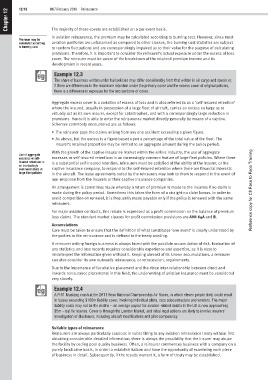Page 346 - M97TB9_2018-19_[low-res]_F2F_Neat2
P. 346
12 12/16 M97/February 2018 Reinsurance
Chapter The majority of these covers are established on a per event basis.
In aviation reinsurance, the premium may be calculated according to burning cost. However, since most
Premium may be
calculated according aviation portfolios are unbalanced as compared to other classes, the burning cost statistics are subject
to burning cost to random fluctuations and are correspondingly impaired as to their value for the purpose of calculating
premiums. Therefore, it is important to consider the reinsurer’s actual exposure under the excess of loss
cover. The reinsurer must be aware of the breakdown of the retained premium income and its
development in recent years.
Example 12.3
The share of business written under hull policies may differ considerably from that written in air cargo and specie or,
if there are differences in the maximum retention under the primary cover and the excess cover of original policies,
there is a difference in exposure for the two sections of cover.
Aggregate excess cover is a variation of excess of loss and is also referred to as a ‘self-insured retention’
where the insured, usually in possession of a large fleet of aircraft, carries an excess so large as to
virtually act as its own insurer, except for catastrophes, and with a correspondingly large reduction in
premiums. Hence it is able to enter the reinsurance market directly generally by means of a captive.
Schemes commonly encountered are as follows:
• The reinsurer pays the claims arising from any one accident exceeding a given figure.
• As above, but the excess is a figure based upon a percentage of the total value of the fleet. The
insurer’s retained proportion may be limited to an aggregate amount during the policy period.
With the growth of the captive insurance market within the airline industry, the use of aggregate
Use of aggregate
excesses or self- excesses or self-insured retentions is an increasingly common feature of large fleet policies. Where there
insured retentions is is a substantial self-insured retention, reinsurers must be satisfied of the ability of the insurer, or the
an increasingly
common feature of captive insurance company, to respond to the self-insured retention where there are financial interests
large fleet policies in the aircraft. The lease agreements noted by the reinsurers may look to them to respond in the event of
non-response from the insurers or their captive insurance companies.
An arrangement is sometimes made whereby a return of premium is made to the insurers if no claim is Reference copy for CII Face to Face Training
made during the policy period. Sometimes this takes the form of a straight no claim bonus. In order to
avoid competition on renewal, it is frequently made payable only if the policy is renewed with the same
reinsurers.
For major aviation contracts, this rebate is expressed as a profit commission on the balance of premium
less claims. The standard market clauses for profit commission provisions are AVN 64A and B.
Accumulations
Care must be taken to ensure that the definition of what constitutes ‘one event’ is clearly understood by
the parties to the reinsurance and is defined in the treaty wording.
A reinsurer writing foreign business is always faced with the possible accumulation of risk. Evaluation of
any statistics and loss records requires considerable experience and expertise, as it is easy to
misinterpret the information given without it. Keeping abreast of its known accumulations, a reinsurer
can also consider its own outwards reinsurance, or retrocession, requirements.
Due to the importance of facultative placement and the close inter-relationship between direct and
inwards reinsurance placements in this field, the underwriting of aviation insurance must be considered
very closely.
Example 12.4
A P-51 Mustang crash at the 2011 Reno National Championship Air Races, in which eleven people died, could result
in losses exceeding $100m liability cover, involving individual pilots, race subcontractors and vendors. The major
liability costs may not be the deaths – an average payout for aviation-related deaths in the US is now approaching
$5m – but for injuries. Cover is through the London Market, and initial legal actions are likely to involve insurers’
investigation of disclosure, including aircraft modifications and pilot competency.
Suitable types of reinsurance
Reinsurers are always particularly cautious in subscribing to any aviation reinsurance treaty without first
obtaining considerable detailed information; there is always the possibility that the insurer may abuse
the facility by ceding poor quality business. Often, a reinsurer commences business with a company on a
purely facultative basis, in order to establish liaison and have the opportunity of examining each piece
of business in detail. Subsequently, if the results warrant it, a form of treaty may be established.

